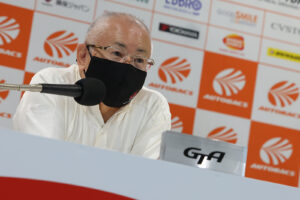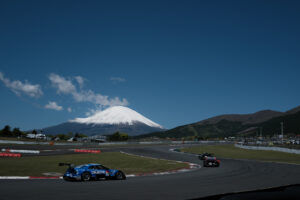For the first time in two years, Super GT celebrated its comeback in the Tohoku region. The first race at Sportsland SUGO since 2019 was a drama-filled and thrilling affair. Before the lights turned green, GTA chairman Masaaki Bandoh talked in a press conference about the increased infection prevention measures, the importance of developing the Japanese motorsports industry and teased a potential the return of the classic Suzuka 1000km for next year.
Revival of the Suzuka 1000km? Masaaki Bandoh reveals plans for 2022
 GTA chairman Masaaki Bandoh dropped a real bombshell in today’s press conference as Super GT is considering to potentially revive the classic Suzuka 1000km for 2022. Bandoh revealed that he heard that the Suzuka 10H, into which the old 1000km race transformed to, might not be able to be held next year either. And with Super GT featuring Suzuka twice on the calendar next year, Bandoh is currently thinking of ways how to envision a return of the old endurance classic, which used to be an official championship round from 2006 until 2017. However, it’s important to point out that said plans haven’t passed the initial thought process just yet, as the GTA first has to talk with all the involved (tyre) manufacturers about the costs as well as the limitation of two engines per season. While this is no problem in GT500, Bandoh explained that the rules might need an overhaul for the GT300 class. As for the initial plans to generally increase the race distance for the 300km rounds next year, Masaaki Bandoh explained that a decision will be made based on how many fans they’re allowed to accommodate at the various circuits next year.
GTA chairman Masaaki Bandoh dropped a real bombshell in today’s press conference as Super GT is considering to potentially revive the classic Suzuka 1000km for 2022. Bandoh revealed that he heard that the Suzuka 10H, into which the old 1000km race transformed to, might not be able to be held next year either. And with Super GT featuring Suzuka twice on the calendar next year, Bandoh is currently thinking of ways how to envision a return of the old endurance classic, which used to be an official championship round from 2006 until 2017. However, it’s important to point out that said plans haven’t passed the initial thought process just yet, as the GTA first has to talk with all the involved (tyre) manufacturers about the costs as well as the limitation of two engines per season. While this is no problem in GT500, Bandoh explained that the rules might need an overhaul for the GT300 class. As for the initial plans to generally increase the race distance for the 300km rounds next year, Masaaki Bandoh explained that a decision will be made based on how many fans they’re allowed to accommodate at the various circuits next year.
Additional infection prevention measures due to positive PCR test results after the Suzuka round
 Masaaki Bandoh revealed that after the previous round at Suzuka, two people tested positive for COVID-19, leading the GTA to strengthen its infection prevention measures. Next to the regular PCR tests, which have to be made two weeks prior to each round (if positive, a substitution driver or staff member has to be appointed), it’s now also required to show an antigen test 72 hours before the race weekend. Without it, said personnel wouldn’t get access to the paddock. The antigen test was originally intended for medical institutions, but have recently been sold to businesses as well. That’s why the GTA asked the Super GT doctors to purchase and distribute them to the health managers of each team. Since Sportsland SUGO isn’t a huge venue, they had to take extra measurs like using shuttle busses and golf carts to transport the personnel from the parking lot to the paddock and to avoid contact with the fans.
Masaaki Bandoh revealed that after the previous round at Suzuka, two people tested positive for COVID-19, leading the GTA to strengthen its infection prevention measures. Next to the regular PCR tests, which have to be made two weeks prior to each round (if positive, a substitution driver or staff member has to be appointed), it’s now also required to show an antigen test 72 hours before the race weekend. Without it, said personnel wouldn’t get access to the paddock. The antigen test was originally intended for medical institutions, but have recently been sold to businesses as well. That’s why the GTA asked the Super GT doctors to purchase and distribute them to the health managers of each team. Since Sportsland SUGO isn’t a huge venue, they had to take extra measurs like using shuttle busses and golf carts to transport the personnel from the parking lot to the paddock and to avoid contact with the fans.
Due to Miyagi Prefecture’s “priority measures” to mitigate the spread of COVID-19, only 5,000 people were allowed to come to the track each day. All tickets had to be purchased in advance. Masaaki Bandoh pointed out that the GTA’s measures are important, not just for Super GT, but for the Japanese motorsport industry as a whole as well. He expects the coronavirus situation to continue next year, which is why they have to find ways to safely conduct each event. Another GTA spokesperson added that 1,700 people underwent a PCR test prior to the weekend.
The GTA is looking into ways how to deal with the scorching summer heat
 A journalist asked GTA chairman Bandoh about future measures to reduce dehydration after multiple drivers suffered a heatstroke at the previous rounds at Motegi and Suzuka. Masaaki Bandoh explained that each team has to make sure that the drink system, air conditioning and cool suits are working properly. It’s the job of the drivers (and teams) to bring the car back to the pits if those systems aren’t working, which is why the GTA is thinking about issuing penalties in the future if such malfunctions are ignored. Chairman Bandoh added that it’s currently hotter in Japan than in Malaysia. It doesn’t make much of a difference whether the race starts at 14:00 or 15:00, as the difference is only about 0.5 degrees Celsius, making it difficult to adjust the start time. The reason for starting early is so that everyone involved can return to their hometowns on the same day instead of staying in the area overnight, which has to be avoided due to the current emergency declarations and infection prevention measures (check out our feature article with more information about the summer heat topic). Additionally, it’s also a way to cut costs in the currently tough economic climate. The reason Super GT is holding both practice and qualifying on Saturday is due to the teams arriving at the track on Friday. However, as Bandoh pointed out, some teams already start setting up on Thursday, which doesn’t help the idea of saving costs. In the future, the GTA wants to listen to all involved parties on how to deal with the summer heat and start time.
A journalist asked GTA chairman Bandoh about future measures to reduce dehydration after multiple drivers suffered a heatstroke at the previous rounds at Motegi and Suzuka. Masaaki Bandoh explained that each team has to make sure that the drink system, air conditioning and cool suits are working properly. It’s the job of the drivers (and teams) to bring the car back to the pits if those systems aren’t working, which is why the GTA is thinking about issuing penalties in the future if such malfunctions are ignored. Chairman Bandoh added that it’s currently hotter in Japan than in Malaysia. It doesn’t make much of a difference whether the race starts at 14:00 or 15:00, as the difference is only about 0.5 degrees Celsius, making it difficult to adjust the start time. The reason for starting early is so that everyone involved can return to their hometowns on the same day instead of staying in the area overnight, which has to be avoided due to the current emergency declarations and infection prevention measures (check out our feature article with more information about the summer heat topic). Additionally, it’s also a way to cut costs in the currently tough economic climate. The reason Super GT is holding both practice and qualifying on Saturday is due to the teams arriving at the track on Friday. However, as Bandoh pointed out, some teams already start setting up on Thursday, which doesn’t help the idea of saving costs. In the future, the GTA wants to listen to all involved parties on how to deal with the summer heat and start time.
Only 30 instead of 40 team members at the upcoming Autopolis round
Masaaki Bandoh confirmed that they’ll require an antigen test for the Autopolis round as well. While there are currently no state of emergency measures for the Oita Prefecture, the GTA can’t ignore the fact that many members will have to stay overnight in the area before returning back home on Monday. Thus, the GTA decided to decrease the number of team members from 40 down to 30 for the next round. As a promoter, their aim is to create events that are safe and secure for everyone involved.
The importance of developing motorsports into a professional sports industry and culture
 Masaaki Bandoh revealed that the GTA underwent some structural changes, which he sees as important when trying to build something new. The GTA is always working on new things and he hopes that Super Formula’s JRP and Super Taikyu’s STO will try to copy what they have achieved if they deem it as good. Motorsport needs to find its acceptance (editor’s note: for example, the Japanese government doesn’t see motorsport as proper sport but rather as entertainment) and although that’s very difficult to achieve, it’s important that it develops into a professional sports industry as well as a culture, Masaaki Bandoh explained. It’s his goal to create the core of that.
Masaaki Bandoh revealed that the GTA underwent some structural changes, which he sees as important when trying to build something new. The GTA is always working on new things and he hopes that Super Formula’s JRP and Super Taikyu’s STO will try to copy what they have achieved if they deem it as good. Motorsport needs to find its acceptance (editor’s note: for example, the Japanese government doesn’t see motorsport as proper sport but rather as entertainment) and although that’s very difficult to achieve, it’s important that it develops into a professional sports industry as well as a culture, Masaaki Bandoh explained. It’s his goal to create the core of that.
F1, WEC and WRC are currently introducing biofuel called e-fuel. While the GTA wants to test with it as soon as possible, they first would have to import it, which costs about 1,000 Yen per liter. To use an example, Bandoh explained that the GTA brought about 25,000 liters of fuel with them to the overseas round in Buriram, Thailand. He hopes that biofuel will be produced domestically in the future. While costly, that decision also depends on the direction set by the Japanese Ministry of Economy, Trade and Industry (METI). The GTA wants to introduce environmental technologies that can be used in both GT500 as well as GT300. They hope to test them as early as 2023. The next step would be to introduce a variety of options such as fuel cells and batteries for 2030. As for the next GT500 regulations: The GTA is still deciding on it based on the global trends as well within the FIA’s safety regulations.
Copyright Photos: GT Association (GTA)


